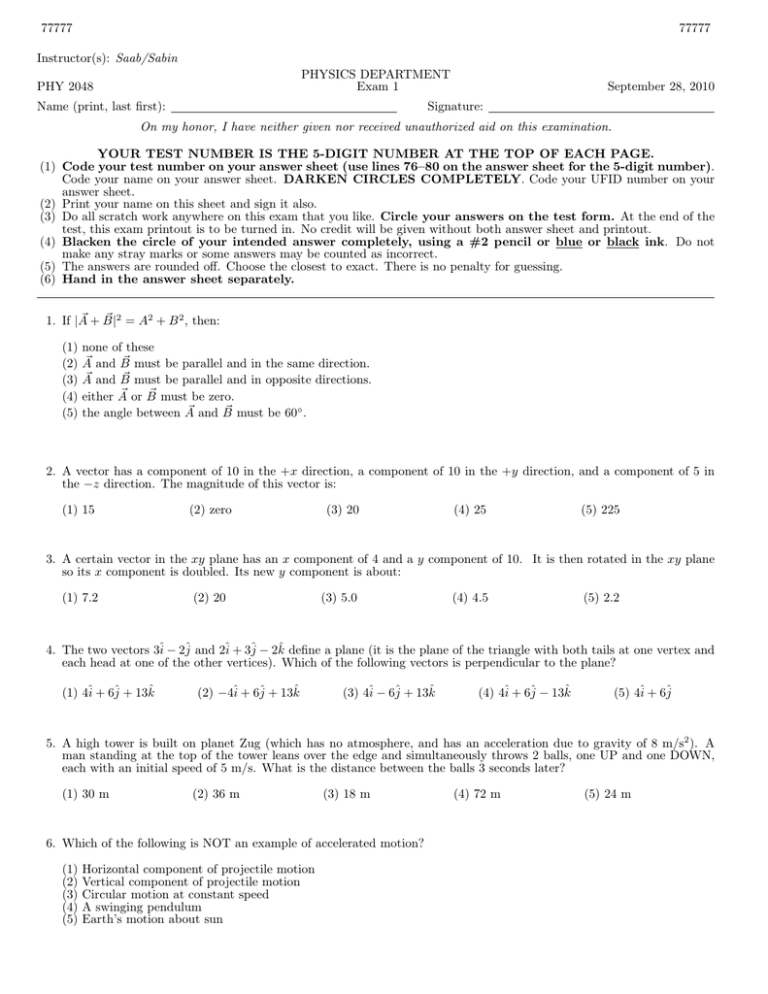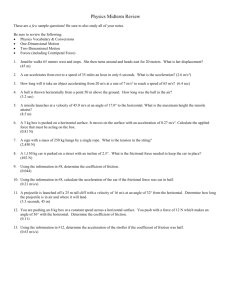77777 Saab/Sabin PHYSICS DEPARTMENT PHY 2048
advertisement

77777 77777 Instructor(s): Saab/Sabin PHYSICS DEPARTMENT Exam 1 PHY 2048 Name (print, last first): September 28, 2010 Signature: On my honor, I have neither given nor received unauthorized aid on this examination. YOUR TEST NUMBER IS THE 5-DIGIT NUMBER AT THE TOP OF EACH PAGE. (1) Code your test number on your answer sheet (use lines 76–80 on the answer sheet for the 5-digit number). Code your name on your answer sheet. DARKEN CIRCLES COMPLETELY. Code your UFID number on your answer sheet. (2) Print your name on this sheet and sign it also. (3) Do all scratch work anywhere on this exam that you like. Circle your answers on the test form. At the end of the test, this exam printout is to be turned in. No credit will be given without both answer sheet and printout. (4) Blacken the circle of your intended answer completely, using a #2 pencil or blue or black ink. Do not make any stray marks or some answers may be counted as incorrect. (5) The answers are rounded off. Choose the closest to exact. There is no penalty for guessing. (6) Hand in the answer sheet separately. ~ + B| ~ 2 = A2 + B 2 , then: 1. If |A (1) (2) (3) (4) (5) none of these ~ and B ~ must be parallel and in the same direction. A ~ ~ must be parallel and in opposite directions. A and B ~ or B ~ must be zero. either A ~ and B ~ must be 60◦ . the angle between A 2. A vector has a component of 10 in the +x direction, a component of 10 in the +y direction, and a component of 5 in the −z direction. The magnitude of this vector is: (1) 15 (2) zero (3) 20 (4) 25 (5) 225 3. A certain vector in the xy plane has an x component of 4 and a y component of 10. It is then rotated in the xy plane so its x component is doubled. Its new y component is about: (1) 7.2 (2) 20 (3) 5.0 (4) 4.5 (5) 2.2 4. The two vectors 3î − 2ĵ and 2î + 3ĵ − 2k̂ define a plane (it is the plane of the triangle with both tails at one vertex and each head at one of the other vertices). Which of the following vectors is perpendicular to the plane? (1) 4î + 6ĵ + 13k̂ (2) −4î + 6ĵ + 13k̂ (3) 4î − 6ĵ + 13k̂ (4) 4î + 6ĵ − 13k̂ (5) 4î + 6ĵ 5. A high tower is built on planet Zug (which has no atmosphere, and has an acceleration due to gravity of 8 m/s2 ). A man standing at the top of the tower leans over the edge and simultaneously throws 2 balls, one UP and one DOWN, each with an initial speed of 5 m/s. What is the distance between the balls 3 seconds later? (1) 30 m (2) 36 m (3) 18 m 6. Which of the following is NOT an example of accelerated motion? (1) (2) (3) (4) (5) Horizontal component of projectile motion Vertical component of projectile motion Circular motion at constant speed A swinging pendulum Earth’s motion about sun (4) 72 m (5) 24 m 77777 77777 7. Two bodies are falling with negligible air resistance, side by side, above a horizontal plane. If one of the bodies is given an additional horizontal acceleration during its descent, it: (1) (2) (3) (4) (5) strikes the plane at the same time as the other body. has the vertical component of its velocity altered. has the vertical component of its acceleration altered. follows a hyperbolic path. follows a straight line path along the resultant acceleration vector. 8. Identical guns fire identical bullets horizontally at the same speed from the same height above level planes, one on the Earth and one on the Moon. Which of the following three statements is/are true? I. The horizontal distance traveled by the bullet is greater on the Moon. II. The flight time is less for the bullet on the Earth. III. The velocity of the bullets at impact are the same. (1) I and II only (2) III only (3) I and III only (4) II and III only (5) I, II, and III 9. A cannon fires a projectile as shown. The dashed line shows the trajectory in the absence of gravity; points MNOP correspond to one second intervals. Using g = 10 m/s2 , the lengths X,Y,Z are (1) (2) (3) (4) (5) 5 m, 20 m, 45 m 5 m, 10 m, 15 m 10 m, 40 m, 90 m 10 m, 20 m, 30 m 0.2 m, 0.8 m, 1.8 m M X N Y Z O P 10. A dart is thrown horizontally toward X at 20 m/s as shown. It hits Y 0.1 s later. The distance XY is: (1) (2) (3) (4) (5) 0.05 m 1m 0.5 m 0.1 m 2m X Y 11. A Newton is the force: (1) (2) (3) (4) (5) that gives a 1 kg body an acceleration of 1 m/s2 . of gravity on a 1 kg body. of gravity on a 1 g body. that gives a 1 g body an acceleration of 1 cm/s2 . that gives a 1 kg body an acceleration of 9.8 m/s2 . 12. The standard 1-kg mass is attached to a compressed spring and the spring is released. If the mass initially has an acceleration of 5.6 m/s2 , the force of the spring has a magnitude of: (1) 5.6 N (2) 2.8 N (3) 11.2 N (4) 0 13. The block shown moves with constant velocity on a horizontal surface. Two of the forces acting on the block are shown. A frictional force exerted by the surface is the only other horizontal force acting on the block. The frictional force is: (5) an undetermined amount 3N 5N (1) 2 N, leftward (2) 0 (3) 2 N, rightward (4) slightly more than 2 N, leftward (5) slightly less than 2 N, leftward 77777 77777 14. A block of mass 2 kg is stationary on a slope of 30◦ to the horizontal. The coefficient of static friction between the block and slope is 0.7. What is the friction force on the block? (1) 10 N (2) 12 N (3) 14 N (4) 7 N 15. A 16-kg block and an 8-kg block are connected by a string as shown. If the pulley is massless and the surface is frictionless, the magnitude of the acceleration of the 16-kg block (in m/s2 ) is: (1) (2) (3) (4) (5) (5) 0 N 16 kg 3.3 0.10 0.15 4.8 9.8 8 kg 16. A box with a weight of 50 N rests on a horizontal surface. A person pulls horizontally on it with a force of 10 N and it does not move. To start it moving, a second person pulls vertically upward on the box. If the coefficient of static friction is 0.4, what is the smallest vertical force for which the box moves? (1) 25 N (2) 10 N (3) 14 N 10 N (4) 4 N 17. Block A with a mass of 10 kg, rests on a 30◦ incline. The coefficient of kinetic friction is 0.20. The attached string is parallel to the incline and passes over a massless, frictionless pulley at the top. Block B, with a mass of 3.0 kg, is attached to the dangling end of the string. The acceleration of B is: (1) 0.20 m/s2 , up (2) 0.20 m/s2 , down (3) 2.8 m/s2 , up (5) 35 N A (4) 2.8 m/s2 , down B (5) 0 18. If a satellite moves above the Earth’s atmosphere in a circular orbit with constant speed, then: (1) (2) (3) (4) (5) its acceleration is toward the Earth. its acceleration and velocity are in the same direction. the net force on it is zero. its velocity is constant. it will fall back to Earth when its fuel is used up. 19. An automobile moves on a level horizontal road in a circle of radius 100 m. The coefficient of friction between tires and road is 0.50. The maximum speed (in m/s) with which this car can round this curve is: (1) 22 (2) 10 (3) 16 (4) 32 (5) 44 20. One end of a 1.0-m string is fixed, the other end is attached to a 2.0-kg stone. The stone swings in a vertical circle, passing the top point at 4.0 m/s. The string tension (in Newtons) at this point is about: (1) 12 (2) 0 (3) 20 (4) 32 (5) 52


